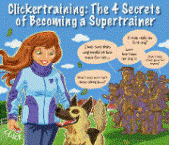Good Dog Training Advice
Get Fast & Simple Dog Training Tips to
Turn a Difficult Dog Into an Obedient Pet!
Got a New Puppy? When Do You Start Obedience Training Them?
You've just picked up your new puppy, gotten him home and setup his little play pen. You're watching him roll around on the padding you got to protect your carpet and nip at your fingers. But, now you're wondering when the training should start and how intensive it should be. Most dog owners start training at the wrong time. Some might start too early when a puppy isn't quite ready to hold their pee or sit and stay. Others wait too long and are faced with a stubborn, messy adolescent dog. So, I want to go over the when and how of your early dog obedience training. House Breaking Housebreaking should not be started until your dog is about 10 weeks old. Ideally, however, you should not even pick up a dog from a breeder or the pound until it is at least 8 weeks old. The reason is that the mother and litter mates are important to have with them for the early weeks. A dog will learn many basic aspects of their social standing in those formative weeks and if you don't give them to them they might develop nipping tendencies or have aggression issues. Additionally, you should highly socialize your dog with people and other dogs as they age. Never, at any point, should a dog not have interactions with other dogs or people before they hit 15 months of age. As for house training a puppy, aim to complete it between 10 and 12 weeks, when the dog has acclimated to your home and has the physical capability of holding it. To facilitate faster training, start crate training your puppy as soon as you move him home. This will ensure they understand how to hold their pee for longer than a few seconds. Basic Obedience Basic obedience training can occur between 3 and 6 months of age. This can be done at home or in a class and should include basics like sit, stay, lay down, roll over, or whatever else you want your dog to know. The basics are all very simple and with the right approach can be taught in a few days. By teaching them young, you not only teach your dog to understand the role you play as their pack leader, but you put those tricks deep down into their heads as specific actions they should remember at all times. Future Training Once basic obedience training is complete, you will have quite a bit of time to train your dog in other ways. Most of the time, those basics are plenty, and because leash training should be done by the time they are 3-6 months old, I don't specifically recommend any other training regimens. However, if you do decide to train your puppy with new tricks, make sure they are old enough to handle the physical stress. A dog should be fully grown before you have them jumping, sprinting, or diving. The stress on a puppy's body can be immense and is believed to contribute to dysplasia. A puppy is a big responsibility. They need lots of attention, stern authority, and the chance to bond with their owner. Training to early can make them anxious and fearful. Too late can make them aggressive and overbearing. So, make sure you get a puppy at the right age, train him on cue, and stay consistent as he ages. Those first few weeks may be trying, but the extra work you put in will come in very handy when your dog reaches maturity and follows your every command. Before you go, make sure you check out Dr. Dog's FAST, EASY, FUN Behavior Solutions: ==> http://gooddogtrainingadvice.com/drdog.html In this jam-packed ebook, you get solid, no-nonsense solutions to every conceivable problem you may face. Here's just a sample of the things you'll discover inside this incredible book... * The four things that dogs need like they need air - absolutely critical before you ever consider anything else about your dog's behavior... (page 2) * The best age to bring a dog into your home and the best days of the week to do it... (page 4) * Why you should never buy your dog from a pet store (sure to rub a few folks the wrong way, but I'm being totally honest here) ... (page 4) * Special considerations when buying an older dog... (page 3) * Beware of the fear imprint! (Learn when a dog is most susceptible and how to avoid making a lasting impression you may long regret.) ... (page 4) * The four best gifts you can give your dog (and a bonus gift you'll both love!) ... (page 40) * Exploding the myth than a professional trainer can solve behavior problems (a well-intentioned trainer may even make things worse!) ... (page 7) * WARNING: Dogs adopt permanent behavior patterns after just one incident. Learn how to avoid the costly mistake of teaching your dog bad behavior without realizing it... (page 5) * The best behavioral "medicine" you can give your dog. It's not a drug or even a treat. Learn when and what to do and prepare to be astonished by the results... (page 12) * Use this amazing little "magic trick" to completely eliminate pulling on lead. You'll soon have a dog on a slack leash, no matter how fast you walk or which direction you turn ... (page 80, 81) * 12 reasons why dogs dig (some may surprise you)... (page 57-61) * Why dogs bark and how to train your dog to bark only when you or your property could be in danger...(page 84-101) * 11 reasons for aggressive behavior and a detailed look at each one ... (page 104-114) * Why dogs fight - understand how your dog reacts to his environment and eliminate any possible conflicts... (page 119) * The very worst thing you can do when two dogs fight (never, ever make this mistake)... (page 138) * The one thing you must absolutely know before attempting to break up a dogfight (get this wrong and you will undoubtedly make things much worse)... (page 137) * And there is a LOT more inside. Check out the website below: | |
|


Discover the Secrets to Training Your Dog Or Puppy. Huge BONUSES for a limited time only!
Click here now...
|
http://GoodDogTrainingAdvice.com







